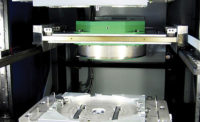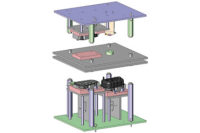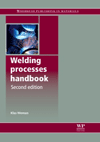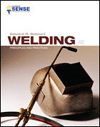Hot-plate welding is one of the simplest and most versatile methods for joining two plastic parts. The technology can weld small parts or large ones, flat parts or contoured ones. It can weld one assembly at a time, or multiple assemblies simultaneously. In many cases, hot-plate welding works when other joining methods, such as ultrasonic welding and vibration welding, do not.
In the automotive industry, the technology is used to assemble headlights, taillights, ductwork, manifolds, batteries, fuel tanks, filter housings, and coolant and fluid reservoirs. Appliance manufacturers use hot-plate welding to assemble spray arms for dishwashers; agitators and balance rings for washing machines; brushes for vacuum cleaners; and reservoirs for steam irons. In the hardware industry, the technology is employed to weld window and door frames. Medical device manufacturers use hot-plate welding to assemble sharps containers and foot massagers. The technique is even used to make large assemblies, such as barrels, pallets and crates.
Hot-plate welding is a six-step process. First, the two halves of the assembly are loaded into custom-made fixtures. Loading is usually performed manually, though it could also be done with a six-axis robot. The fixtures can be vertically or horizontally oriented. A vacuum port can be installed at the back of one or both fixtures to hold the parts in place. When loaded, only a small portion of each part protrudes from the fixture.
The orientation of the fixtures depends on the application. Vertical fixtures are often preferred, because they’re easier for operators to load. With horizontal fixtures, operators may have difficulty seeing, and therefore loading, the upper half of the fixture. Headlight and taillight assemblies are typically done in vertical fixtures.
On the other hand, horizontal fixtures are best if the assembly has internal components. That way, components can be inserted into the lower half of the assembly without fear of the parts falling out. Horizontal fixtures are also better for long, flexible parts, such as the ductwork for an automotive dashboard.
The fixtures are connected to linear slides powered by pneumatic cylinders, hydraulic cylinders or servo-driven ballscrews. The latter lets engineers precisely control welding force, speed and displacement. It can also detect errors, such as a warped part or a part that has been loaded incorrectly.
When the machine is actuated, a heated platen moves in between the two fixtures. The fixtures then press the parts against the platen for a set time until a small portion of plastic around the edge of each part melts. Mechanical stops built into the fixtures and platen prevent too much material from being melted. (Servo control obviates the need for hard stops.)
Once the plastic has melted, the fixtures move apart, the platen withdraws, and the fixtures travel toward each other again. The parts are pressed together and held for a set time so the melted edges fuse as the plastic cools. Finally, the fixtures separate again, and the assembly is unloaded.
All totaled, cycle time for hot-plate welding ranges from 10 seconds to nearly a minute.
The platen is a flat piece of aluminum, P20 mold steel or aluminum-bronze, approximately 1 inch thick. The length and width of the platen range from 10 inches by 15 inches to 72 inches by 24 inches. Electric cartridges inside the platen supply the heat. Depending on the machine and the size of the platen, engineers can control the temperature in individual zones, so some parts of the assembly can get more heat while others get less.
Aluminum is for low-temperature applications; steel is for high-temperature applications. Aluminum-bronze recovers heat a little faster than steel, so it’s often preferred for high-volume applications.
To weld contoured parts, blocks of aluminum or steel, machined to match the shape of the parts, are attached to each side of the platen. A nonstick coating, such as Teflon or chrome, is often applied to the tooling to keep the melted plastic from sticking. The key to welding contoured parts is keeping the temperature the same from the lowest point of the block to the highest point.
The parameters of the hot-plate welding process—platen temperature, heating time, transition time, joining pressure and holding time—vary with the size, shape and composition of the parts.
Platen temperature ranges from 150 to 650 F. For noncontact applications—in which the parts are held close to the platen without touching it—platen temperature could be as high as 1,000 F. Noncontact heating is reserved for materials that will stick or burn if they touch the platen. However, because heat transfer is less efficient in noncontact operations, cycle time will increase.
Heating time varies substantially from one application to the next, ranging from 1.5 seconds to 20 seconds. Amorphous materials will melt faster than engineering-grade polymers.
The pressure applied to the heated parts is minimal, ranging from 14 to 150 psi. The pressure and the displacement, or how far the parts are pushed into each other, must be carefully controlled to avoid squeezing too much molten plastic from the joint and thereby weakening the weld.
Transition time is the time from when the parts are removed from the platen to when they are pushed together. This must be kept as short as possible so the plastic stays molten for the joining process. Holding time is typically a few seconds.
To increase throughput, multiple assemblies can be welded at the same time. For example, taillamp assemblies are often done two at a time. The right-side and left-side lights will be done at the same time, or more commonly, two right-side lights will be done in one machine, and two left-side lights will be done in another.
The latest computer-controlled welders can collect a variety of data for traceability and quality control. They can also store parameter setups in memory to simplify changeovers.
Hot-Plate vs. Other Techniques
Compared with ultrasonic welding and vibration welding, hot-plate welding has two big advantages: It can weld large parts and curved parts. And, because of the amount of material that is melted, hot-plate welding produces strong, hermetically sealed joints. Hot-plate welding can be used on tall, thin, non-supported interior walls, and it is highly forgiving of variations in the molded parts.
In many cases, hot-plate welding can join plastics that other techniques cannot. For example, polypropylene is difficult to join with ultrasonic welding, because the soft plastic absorbs the high-frequency vibrations like a sponge. Hot-plate welding, which does not rely on friction to generate heat, welds polypropylene easily.
On the other hand, hot-plate welding is slower than ultrasonic welding and vibration welding. And, melted plastic sticking to the tooling can be an issue with some materials.
Design for Hot-Plate Welding
Most thermoplastic materials can be joined using hot-plate welding. The technique works with acrylic-styrene-acrylonitrile, acrylonitrile-butadiene-styrene (ABS), ethylene-propylene-diene-monomer, polyamide, polybutylene terephthalate (PBT), polycarbonate, polyethylene, polyethylene terephthalate (PET), polymethylmethacrylate (PMMA), polyoxymethylene, polyphenylene oxide, polyphenylene sulfide, polypropylene, polystyrene, polysulfone, polyvinyl chloride (PVC), polyvinylidene fluoride and thermoplastic elastomer. Some materials, such as Durethan polyamide from Lanxess AG, have been formulated specifically for use with hot-plate welding.
Hot-plate welding also works well with many plastic blends, such as PMMA with ABS; PMMA with PVC; PMMA with polystyrene; polycarbonate with PBT; and polycarbonate with PET. Other blends, such as PVC with ABS or high-density polyethylene with polypropylene, are less conducive.
Dissimilar materials with similar melting points and melt viscosities can be welded if they are chemically compatible. For example, hot-plate welding can be used to join ABS to polycarbonate, PMMA or styrene acrylonitrile.
Fillers, such as glass or talc, can be added to the plastic, as long as the concentration is kept under 30 percent. However, because filler materials don’t melt or redistribute evenly in the weld, the strength of the joint will be diminished. Amorphous thermoplastics that absorb moisture from the surrounding air could have enough water content to cause bubbles to form during the heating and joining phases, and that can reduce the strength of the weld.
A butt joint, either straight or flanged, is the most common joint formed by hot-plate welding. Flash is normally produced around the weld line. However, flash traps can be designed into the parts to hide the joint.
In hot-plate welding, the fixtures can be vertically or horizontally oriented. A vacuum port can be installed at the back of one or both fixtures to hold the parts in place. Photo courtesy Forward Technology
When designing parts for hot-plate welding, engineers should remember that a small portion of each part will be consumed by the weld. On typical flat joints, approximately 0.015 inch of plastic will melt from each part during the initial heating phase. An additional 0.015 inch of material will be lost when the parts are pushed together to form the weld. Thus, if the final assembly must be a certain height, engineers will need to add 0.03 inch of material to each part.
If the assembly will be pressurized, engineers may want to increase the thickness of the part near the joint. As a rule of the thumb, the thickness of the joint should be 1.5 times the nominal wall thickness. For example, if the walls of a windshield washer fluid reservoir are 0.1 inch thick, the width of the joint should be at least 0.15 inch wide.
As with any assembly project, engineers are well-advised to consult with their equipment and material suppliers early in the design process.











